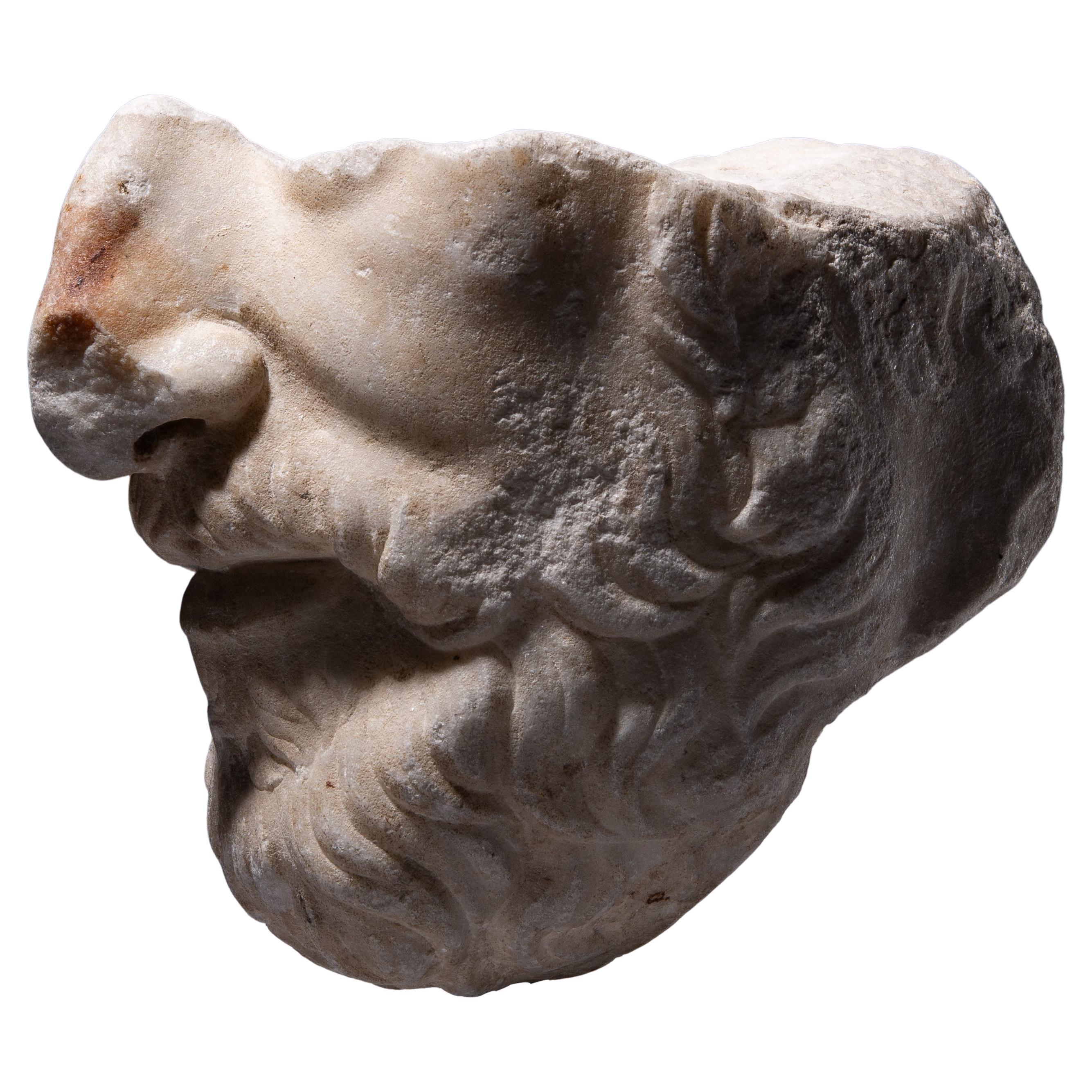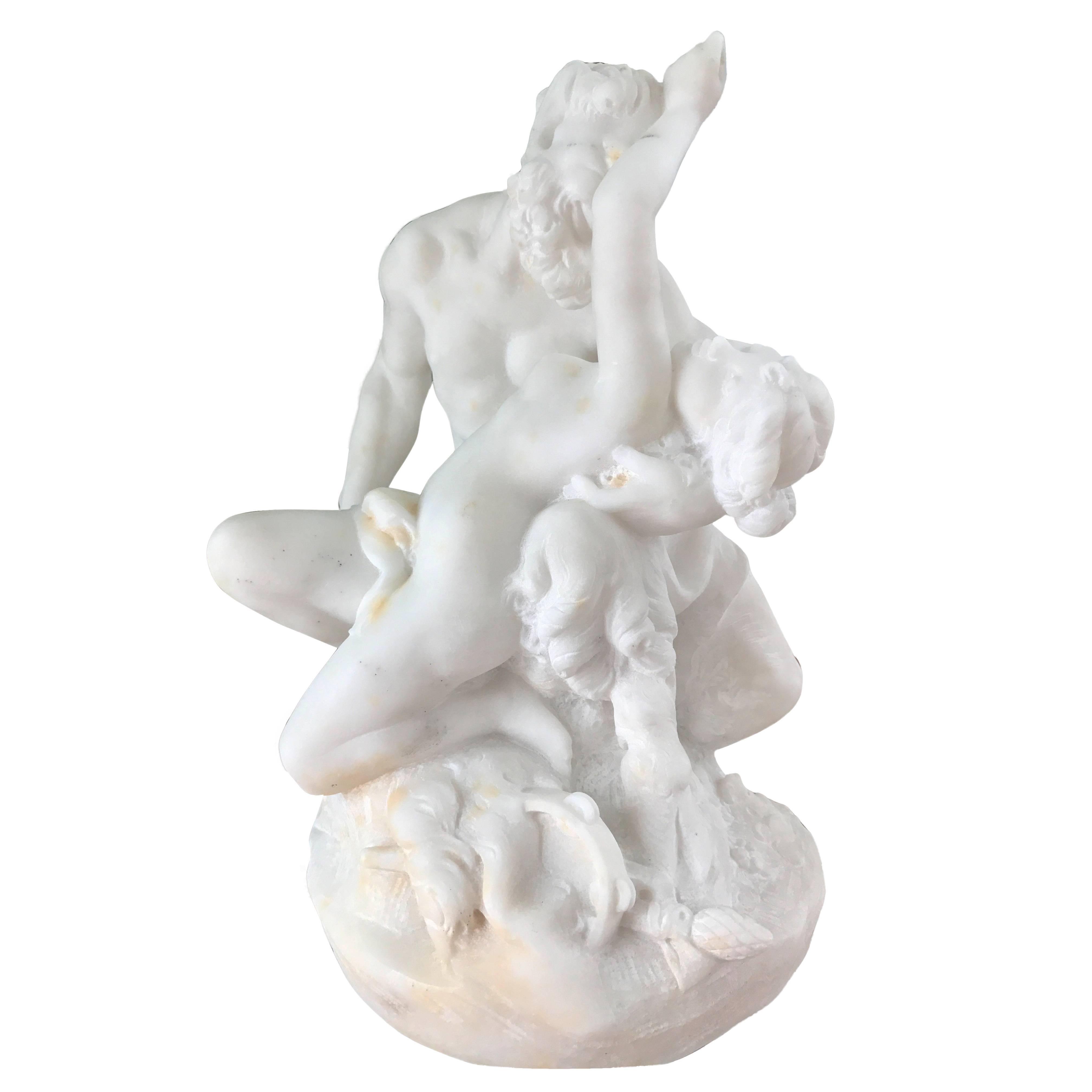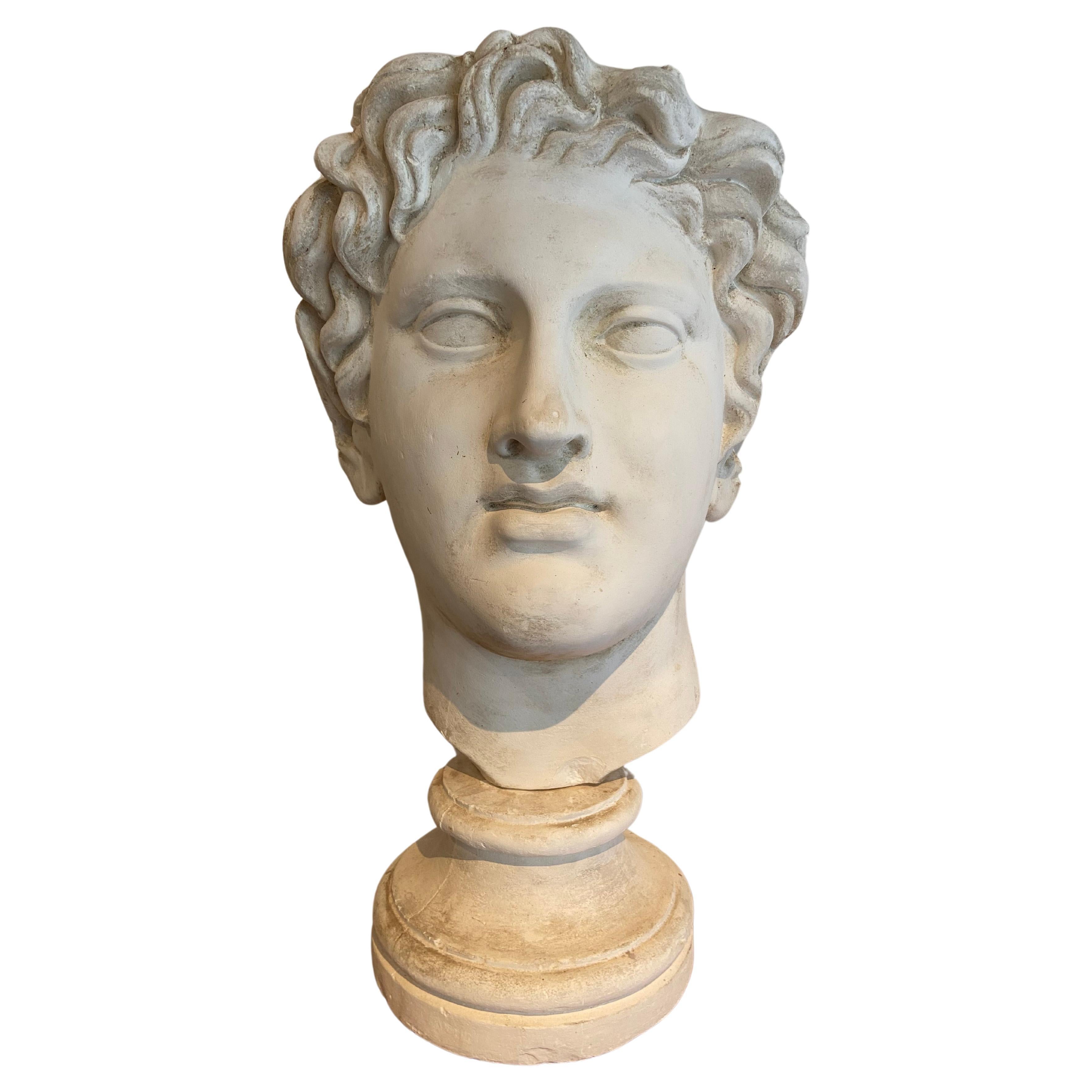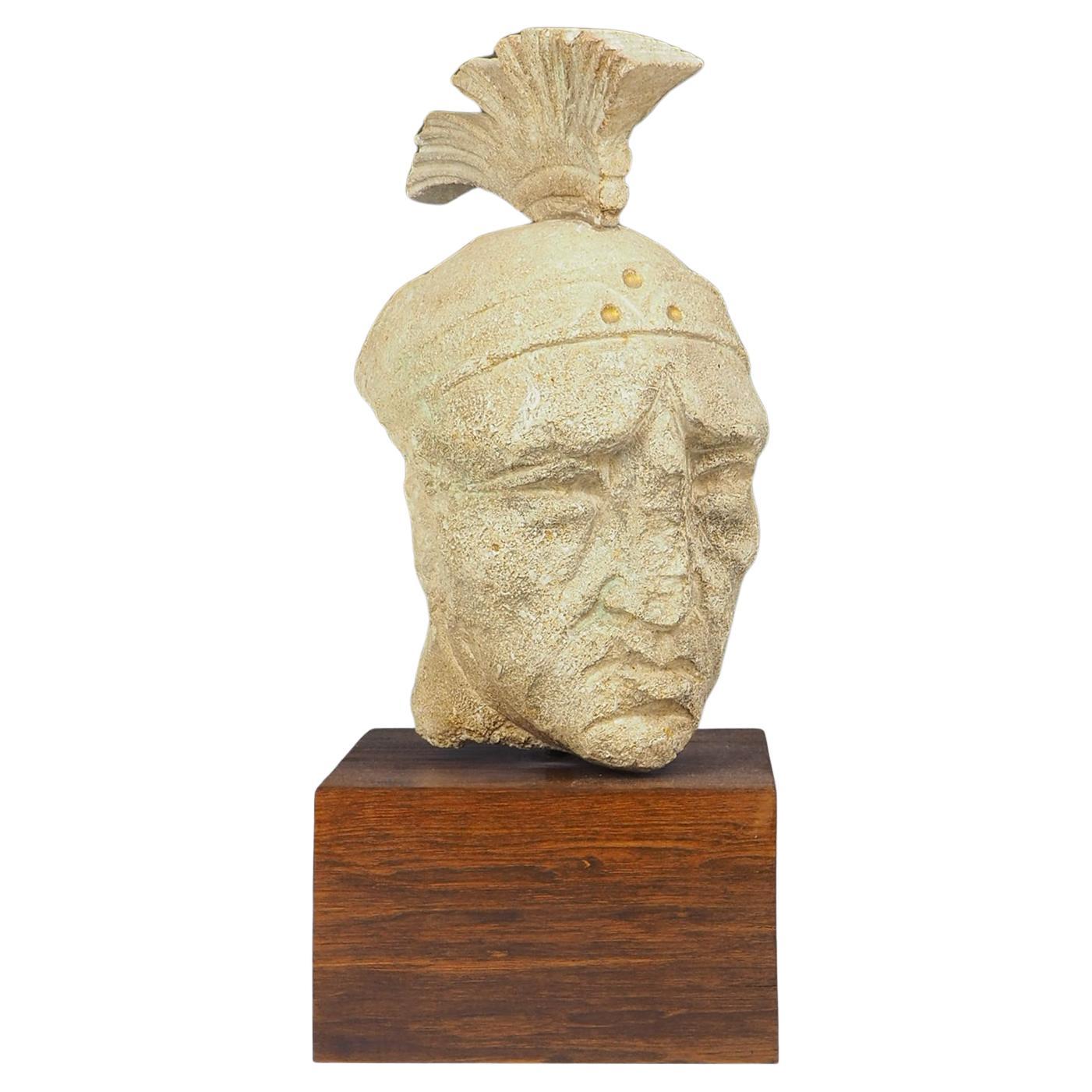Items Similar to Roman Marble Head of a Satyr
Want more images or videos?
Request additional images or videos from the seller
1 of 12
Roman Marble Head of a Satyr
About the Item
Head of a Satyr
Roman, circa 2nd - 3rd century AD
Carved and highly polished marble
An extremely fine marble head of a satyr, depicted with ivy wreath, curly hair and pointed goat’s ear, the full lips slightly parted to reveal the creature’s clenched teeth.
The head was once part of a relief with visible fragmentation on the left side. Almost completely worked in the round and carefully polished, the skill of the sculptor is particularly remarkable given the confined working space available for a relief carving, such as this.
The Roman Imperial Period marked the expansion of the political and cultural influence of the Roman Empire. The period began with the reign of Augustus in 27 BC, immediately following Caesar’s assassination which ultimately ended Rome’s time as a republic. Soon after, Augustus’ defeat of Anthony and Cleopatra at the Battle of Actium (30 B.C.) led to the conquest of Egypt, and annexation of the country under Roman rule. Following his death, his successors continued pushing Rome’s frontiers further, and in 96 AD, the Nerva-Antonine Dynasty greatly facilitated the Empire’s development, as well as producing renowned leaders such as Hadrian and Marcus Aurelius. At the period’s height in 117 AD, Rome controlled all the land from Western Europe to the Middle East, expanding the artistic influences from the varied cultures of the ancient world which Rome had enjoyed for centuries. By this point, Roman art had taken on at- tributes of the Greek, Egyptian and Etruscan Empires, with particular influence drawn from Greek mythology.
Satyrs were originally figures from Greek mythology who, guilty of hedonistic pursuits, excessive sexual desires and drunkenness, were followers of the god of wine, Dionysos (known to the Romans as Bacchus). The Romans, however, identified satyrs with their own nature spirits, fauns, who by contrast were typically seen as shy, woodland creatures. In both cultures, they had the upper body of men, but the horns, legs or tail of a goat. Ovid in his Metamorphoses classified them with sylvans and other country- side divinities to whom Zeus granted the right to live in peace in the woods and forests, far from the viciousness of men (1.192). Lucretius similarly noted that his contemporaries believed in ‘goat-legged’ (capripedes) satyrs, along with nymphs who lived in the mountains and fauns who played rustic music on stringed instruments and pipes (De rerum natura, 4.580). Indeed, in Roman era depictions, satyrs and fauns are both associated with music and revelry.
The present piece depicts the marble head of a satyr, and on account of its fracture and apparent distortion, it is likely a fragment from the relief of a decorative object or a sarcophagus. Exquisitely carved, the sculptor skilfully adapted the perspective to shape the present head in extremely high relief. On account of its size and finish, the object in question would certainly have been made for a particularly high-ranking individual.
Relief’s bearing figures of this size can be seen on the Warwick Vase, a Roman marble sculpture discovered in fragments in the grounds of Emperor Hadrian’s palatial villa near Tivoli, in 1771 (Fig. 1).2 The Bacchic imagery on the Warwick Vase, and indeed the other sculptures found in the villa’s gardens, evoked the pleasures of life enjoyed through wine and feasting - a fitting decorative agenda for the Emperor’s private pal- ace, and retreat from day-to-day life in Rome.
The present fragment might equally have come from a Roman sarcophagi, which were becoming increasingly popular throughout the late imperial period and into the second century AD. Narrative scenes from Greek mythology were a popular choice for decoration, reflecting the upper-class Roman taste for Greek culture and literature. The cult of Dionysus, in which satyrs would have formed a central role, seemed to have been a popular theme, reflecting the compositions and style of classical Greek art. In particular, Dionysiac scenes evoked celebration, offered hope for a pleasurable afterlife, as well as reflected the idea of death as a release from the cares of the world.
Provenance
From the collection of Bo Ive, Denmark (1922 - 1981), thence by descent
Subsequently Bruun Rasmussen, Auction 914, 15 June 2023, Lot 806
- Dimensions:Height: 5.91 in (15 cm)Diameter: 5.91 in (15 cm)
- Materials and Techniques:
- Period:
- Date of Manufacture:Circa 2nd - 3rd century AD
- Condition:
- Seller Location:London, GB
- Reference Number:1stDibs: LU1052239325312
About the Seller
5.0
Recognized Seller
These prestigious sellers are industry leaders and represent the highest echelon for item quality and design.
Established in 2008
1stDibs seller since 2014
100 sales on 1stDibs
Typical response time: 7 hours
Associations
LAPADA - The Association of Arts & Antiques DealersInternational Confederation of Art and Antique Dealers' AssociationsThe British Antique Dealers' Association
- ShippingRetrieving quote...Ships From: London, United Kingdom
- Return PolicyA return for this item may be initiated within 14 days of delivery.
More From This SellerView All
- Roman Marble Head of SophoclesLocated in London, GBRoman Marble Head of Sophocles Circa 1st-2nd Century Marble This fine Roman marble head preserves the proper left side of the face of a middle-aged man, with broad nose, soft lips, and bearded chin. The short beard and sideburns have been finely carved with a flat chisel, to render the soft, wavy strands of hair. The cheekbone, undereye, and nasolabial folds have been delicately modelled in the marble by a skilled hand. In a letter from 1975, the former director of Ny Carlsberg Glyptotek, Copenhagen, suggested that the head could depict the Ancient Greek tragedian Sophocles. Few figures in the Classical world stand aside Sophocles (c. 496-406 BC), inarguably the best known of the Athenian tragedians, in terms of the impact his works have had on the history of art and literature. The psychological depth he achieves in the seven of the 123 of his plays that have survived to the present day - most notably the three Theban plays: Antigone, Oedipus the King, and Oedipus at Colonus - not only inspired the Athenians, among whom Sophocles was honoured as a hero long after his death, but in our own time, have provoked landmark works on phychoanalysis and literary criticism, by thinkers like René Girard and, most famously, Sigmund Freud. In its masterful treatment of the marble this fragment sensitively captures the features of one of the most important playwrights of all time. Height on stand: 7.9 inches (20 cm). Provenance: Collection of Danish sculptor Jens Adolf Jerichau...Category
Antique 15th Century and Earlier Classical Roman Busts
MaterialsMarble
- Roman Marble Statuette of JupiterLocated in London, GBRoman Marble Fragment of jupiter Circa 2nd-3rd Century A.D. Measure: Height: 19.7 cm This beautiful Roman fragmentary statuette depicts Jupiter, the king of the gods, here recognisable from his two chief attributes, the eagle with outstretched wings - according the Pseudo-Hyginus, singled out by Jupiter because ''it alone, men say, strives to fly straight into the rays of the rising sun'' - and the base of the scepter, which remains at the side of the left foot, an aspect likely borrowed from the statue of Zeus at Olympia, once one of the Seven Wonders of the World. Though much of the original piece has been lost, the subtle anatomical detail in the feet mark this out as a piece of exceptional quality, and the work of an artist of particular talent and patience - as Johann Winckelmann once said of the famous Belvedere Torso, ''if you contemplate this with a quiet eye [...] the god will at once become visible in this stone.'' This fragment once caught the eye of Henry Howard, 4th Earl of Carlisle (1694-1758), a Knight of the Garter and among the most prolific collectors of his day. The piece, acquired during his travels to Rome, was proudly displayed on an alcove of the Western Staircase of Castle Howard...Category
Antique 15th Century and Earlier Italian Classical Roman Figurative Scul...
MaterialsMarble
- Roman Marble FootLocated in London, GBRoman marble Fragment of a Right Foot with Sandal Circa 1st - 2nd Century A.D. An evocative Roman marble fragment, preserving the front portion of an over-lifesized sandalled foot. The toes, nails, and bridge of the foot have been sensitively carved. The outer sole of the sandal remains, with delicate, pointed straps joining between the first two toes in a diamond shape. This fragment once belonged to Danish sculptor Jens Adolf Jerichau...Category
Antique 15th Century and Earlier Italian Classical Roman Figurative Scul...
MaterialsMarble
- Ancient Greek Hellenistic Bronze Statuette of SatyrLocated in London, GBBeautifully cast statuette of a satyr, Greek, Hellenistic Period, 3rd-2nd Century BC, solid cast bronze The present work is a wonderful example of the finest Hellenistic style. The ...Category
Antique 15th Century and Earlier Greek Classical Greek Figurative Sculpt...
MaterialsBronze
- Egyptian Head of a ManLocated in London, GBEgyptian head of a man, carved granite. 18th Dynasty, circa 1550-1292 B.C. Carved in beautiful dark granite, this head depicts an elite individual, perha...Category
Antique 15th Century and Earlier Egyptian Egyptian Busts
MaterialsGranite
- Roman Portrait Bust of a Noble WomanLocated in London, GBRoman miniature bust of a noble woman, carved marble, Severan Dynasty, c. 225 A.D. Rare and particularly elegant ‘wig portrait’ of a noble woman, belonging to the early 3rd Century - a style distinctive of Severan Dynasty female portrait busts, in which part of the head has been chiselled away to allow for the addition of a separate hairpiece, in many cases from a darker material, in order to create an almost painterly effect, in the interplay of different coloured stones. The degree of naturalism and emotional depth achieved in a piece of such a small scale implies a sculptor of great talent. The subtle parting of the lips, in combination with her upturned, vacant gaze and tired eyes, conveys a pensive mood, and even a quiet melancholy. A woman strolls the town in thick wigs bought with gold, Then buys new hair to complement the old. And having bought, she doesn’t blush! Right there she buys, Before Alcides’ and the Muses’ eyes. (Ovid, Ars Amatoria, III, 161-168) The fashion of wig-wearing in this period, as well as its emulation in the wig portrait bust, is widely attributed to Julia Domna...Category
Antique 15th Century and Earlier Italian Classical Roman Busts
MaterialsMarble
You May Also Like
- Roman Style Marble HeadLocated in Southall, GBA richly weathered marble Roman style head with skilfully carved features and full lips. The piece would have been part of a larger statue or carving. The marble has a lovely warm pa...Category
Antique 15th Century and Earlier European Classical Roman Figurative Scu...
MaterialsMarble
- Marble Sculpture of SatyrLocated in New Haven, CTMasterfully executed marble sculpture of Marsyas with lover. French after the Greek Antique Ca 1780Category
Antique 1780s French Classical Greek Figurative Sculptures
MaterialsMarble
- Stucco head of a roman figureLocated in 'S-HERTOGENBOSCH, NLStucco head of a Roman figure. Signed on the back (unknown). The head is separate from the base.Category
Vintage 1950s Italian Classical Roman Busts
MaterialsStucco
- Roman Horse-head ResinLocated in Dallas, TXRoman Horse-head on stand from Belgium.Category
2010s Belgian Figurative Sculptures
MaterialsResin
- Antique Venetian Stone Head of a Roman GladiatorLocated in Lincoln, GBAntique Venetian Sandstone Head of a Roman Gladiator is a captivating piece of art that showcases the exquisite craftsmanship of the Venetian artisans. This stunning sculpture depict...Category
Antique 18th Century Italian Busts
MaterialsLimestone
- Pair of marble sculptures of Roman gladiatorsLocated in Rome, ITRefined pair of marble sculptures of Roman gladiators, ADDITIONAL PHOTOS, INFORMATION OF THE LOT AND QUOTE FOR SHIPPING COST CAN BE REQUEST BY SENDING AN EMAIL - Raffinata coppia di...Category
Mid-20th Century Figurative Sculptures
MaterialsMarble





